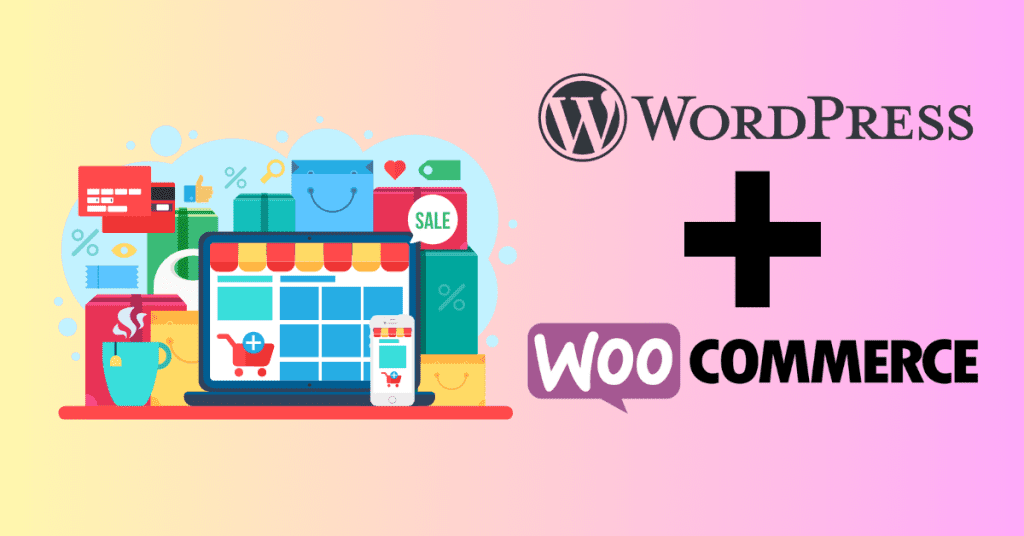Starting a blog is not only a fantastic way to express your thoughts and ideas but can also open doors to income generation. We’re thrilled to guide you through the step-by-step process of creating a blog using WordPress, one of the world’s most popular and user-friendly platforms.
Whether your goal is to share unique knowledge, build a community around a common interest, or pursue financial freedom, starting a WordPress blog can be your stepping stone toward success. As we embark on this journey, remember that every successful blogger started exactly where you are now.
Before we delve into the steps to create your blog, it’s essential to emphasize the importance of spending time on planning and strategy. Now, let’s explore the five simple steps to kickstart your blog and begin the wonderful journey of bringing your ideas to life.
Start Your Blog with Bluehost Hosting
Strategy Planning Before Starting A WordPress Blog
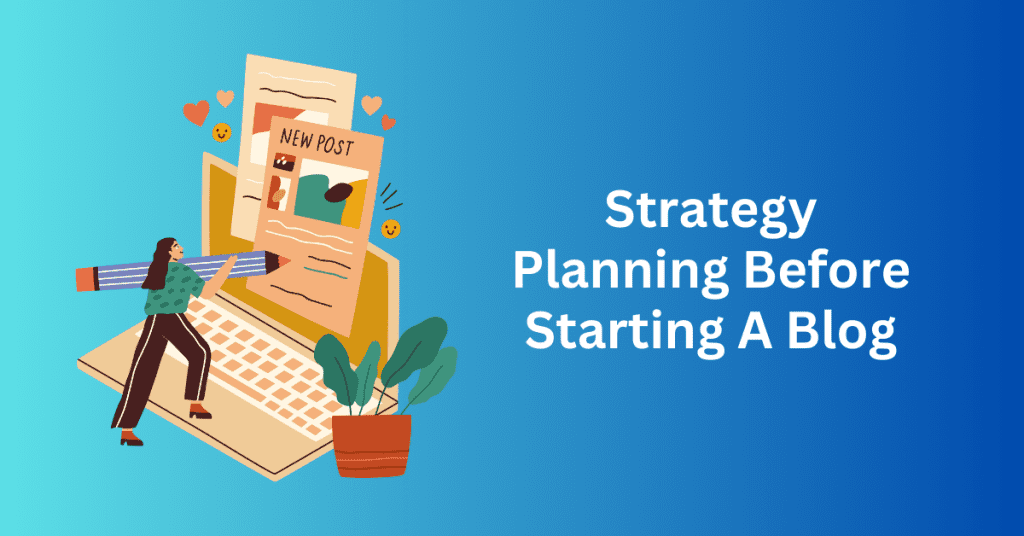
Embarking on the journey of starting a WordPress blog is exciting. However, success in the blog space doesn’t happen overnight. To ensure your blog survives and thrives, a well-thought-out strategy and planning are essential. Here are some key tips to consider as you lay the groundwork for your blogging venture:
1. Define Your Purpose and Niche
Before you start typing away, step back and ask yourself: Why am I starting this blog? Clarifying your purpose and identifying your niche is crucial for attracting a target audience. You can start by considering your passions, expertise, and what makes your perspective unique. A focused niche not only helps you stand out but also makes it easier to tailor your content to a specific audience.
2. Know Your Audience
Understanding your target audience is fundamental to creating content that resonates. You can research their demographics, interests, and online behaviours. By doing so, you can tailor your content to meet their needs and preferences. In addition, you can engage with your audience through surveys, comments, and social media to gather valuable insights that can inform your content strategy.
3. Develop a Content Calendar
Consistency is key in the blogging world. A content calendar helps you plan and organize your posts. This can ensure a steady stream of content that keeps your audience engaged.
You may schedule posts in advance, considering seasonal trends, holidays, and relevant industry events. This not only helps you stay on track but also allows for strategic content planning.
4. Monetization Considerations
If your goal is to monetize your blog, plan your strategy from the beginning. Research and choose appropriate monetization methods, whether through affiliate marketing, sponsored content, or selling products/services.
You need to plan carefully from the beginning to integrate these strategies seamlessly into your content while maintaining authenticity and trust with your audience.
5. Stay Flexible and Analyze Results
You need to review and analyze your blogging strategy regularly to increase your performance. You can do this by monitoring your website’s key performance indicators (KPIs) such as website traffic, engagement metrics, and conversion rates. Besides, you may use analytics tools like Google Analytics to gain insights into what’s working and what needs adjustment. You need to set clear, achievable goals that give you a sense of direction and a measure of success.
By incorporating these strategy and planning tips into your blogging journey, you set yourself up for long-term success.
Step 1: Choose a Website and WordPress Blog Hosting Company
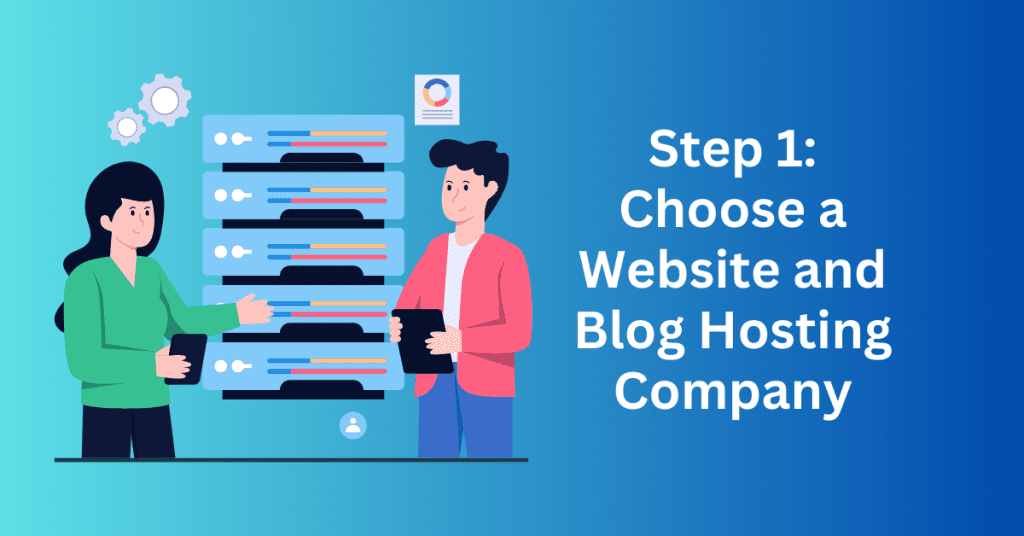
You need to store your WordPress blog somewhere so your audiences can visit it. There are many different web hosting companies out there offering similar services. However, there are different aspects that you need to consider when choosing your hosting company. You definitely don’t want any downtime for switching from one to another.
Start Your Blog with Bluehost Hosting
How to Choose The Hosting Company for Your Website
Choosing the right website and blog hosting company is a crucial decision that can significantly impact the success and performance of your online presence. With numerous options available, it’s essential to carefully evaluate your needs and consider several factors before making a final decision.
Firstly, assess your website’s requirements. Different hosting providers offer various plans tailored to different needs, such as shared hosting, virtual private servers (VPS), dedicated servers, and cloud hosting. Consider the size and complexity of your website, as well as the expected traffic volume. Shared hosting is suitable for small websites with moderate traffic, while larger and more complex sites may benefit from VPS or dedicated hosting.

Secondly, evaluate the hosting company’s reliability and performance. Look for providers with a strong reputation for uptime and fast loading times. You can do some research, and read reviews and testimonials from other users to provide valuable insights into the hosting company’s reliability. Besides, depending on where your business operates, consider the data centre locations and infrastructure of the hosting provider. These factors can impact the speed and accessibility of your website for users across the globe.
Security is another critical aspect to consider. A reliable hosting company should prioritise security measures to protect your website and data from potential threats. This includes features like SSL certificates, regular backups, and robust firewalls. Additionally, check if the hosting provider offers tools and resources to enhance the security of your website, such as malware scanning and DDoS protection.
Finally, consider the level of customer support provided by the hosting company. A responsive and knowledgeable support team is essential for resolving issues promptly. Look for providers that offer 24/7 customer support through various channels, such as live chat, email, or phone.
Start Your Blog with Bluehost Hosting
How to Install Hosting For Your WordPress Blog
If you are not sure which to choose, I would recommend starting with Bluehost. Bluehost is one of the hosting companies recommended by WordPress. Besides, it offers different hosting plans that are optimized for WordPress. In addition to its standard shared, VPS and Dedicated hosting plan, it provides WordPress hosting and eCommerce hosting plan. These plans are optimized for better performance on WordPress.
To start, you can navigate to the Bluehost hosting page and select the “Get Started” button. There are different plans available for you to choose to start.

If you’re a new blogger, it’s advisable to explore the shared hosting options. These plans are cost-effective and well-suited for websites with modest monthly traffic. You can always upgrade to VPS or dedicated hosting anytime when your website traffic grows.
Step 2: Choose A WordPress Blog Name and Domain Name
Your blog name is very important for your blog. It’s the name and branding for your blog. You want to make it relatable and easy to remember for your target audience. This is important as it will give a good first impression about your blog. Also, it can show professionalism and is easy to remember for them.
Hence, it is important to select a good name before starting your blog. Select one that is related to your blog niche, simple and easy to memorize.
Now that you have your blog name, you can select a domain name that is related to your blog name.
But what exactly is a domain name? It’s what users type into the address bar to access your website. A domain name essentially serves as the foundation for your entire brand. Bluehost not only allows you to secure your domain name but also offers web hosting services to support your online presence.
In addition, Bluehost does offer a one-year free domain name with all its hosting plans. You can input your desired domain name, and Bluehost will check on its availability.
If the domain name you select is not available, you may try other top-level domains (TLDs) like .com, .net, .org or country-code TLDs like .co.uk, .us, .au.
Start Your Blog with Bluehost Hosting
How to Choose The Right Domain Name
The best domain names aren’t necessarily humorous or flashy. Instead, they should be easily memorable and contribute to Google’s understanding of your blog’s content.
Consider, for instance, launching a WordPress blog focused on Travel. Which domain name is more suitable: “BennieTravelToTheWorld” or “FlyMeToTheWorld”? While the second option sounds more interesting, it does not tell the website’s purpose clearly. Hence, the first one is a better option here.
Once you’ve settled on your domain name, proceed by providing basic account information, selecting any add-on services of interest, filling in payment details, and then submitting the information.
Your hosting account is now established. Now, you are officially prepared to install WordPress.
Step 3: Install WordPress
Installing WordPress might seem like a complex task, but Bluehost simplifies the process for you by offering an easy one-click installation feature. Here’s how you can do it:
- Start by logging in to your Bluehost account manager.
- Navigate to the Hosting tab in the left menu.
- In this section, you’ll find a list of all the sites you’re currently hosting. If you’re initiating a new site, click on “Add Site.”
- You’ll be prompted to enter a site title and a domain title. Click on “Continue” when you’re ready.
- Bluehost will now install WordPress for you. It’s a one-click installation where you don’t need to do anything. Bluehost will take care of the entire process.
- Once the installation is complete, your new site will be visible in the “Sites on [Your Hosting Plan]” overview. You can click on “Setup.”
- Then, you will be directed to your WordPress admin page.

Log in to Your Blog
Logging into your site is a breeze, and while using the Bluehost account manager is one method, WordPress offers an equally straightforward alternative. Here’s how you can effortlessly log into your WordPress blog:
- Bluehost Account Manager:
- Log in to your Bluehost account manager.
- WordPress Direct Login:
- Alternatively, you can use the direct WordPress login method:
- Open your web browser and enter your domain URL.
- Add “/wp-admin” to the end of your domain URL.
- For instance, if your domain is ‘www.YourDomainName.com,’ type ‘www.YourDomainName.com/wp-admin’ into the address bar.
- Hit enter.
- Alternatively, you can use the direct WordPress login method:
- Enter Credentials:
- You’ll be directed to the WordPress login page.
- Enter your admin username and password.
That’s it! Whether through the Bluehost account manager or the direct WordPress login method, accessing and managing your blog is a simple process.
Step 4: Choose a Theme and Design Your WordPress Blog
Embarking on the journey of creating a blog involves a crucial step: choosing the right WordPress theme. This theme significantly influences your website’s overall appearance, ambience, and style, impacting elements like colour scheme, layout, and stylistic features. Essentially, it serves as a direct reflection of your brand, shaping the experience for your users.
With the abundance of available themes, selecting the right one for your blog can be overwhelming. A widely adopted approach is opting for a free WordPress theme. However, it’s important to remember that your blog represents you and your passion.

Selecting and customizing your theme is akin to curating the decor of your living space, creating an environment that makes your audience feel comfortable, intrigued, and inspired to return.
Regardless of the theme you choose, there are key principles to consider:
- Readability: Opt for a theme with easy-to-read fonts (such as Arial, Courier, or Verdana) to enhance content readability.
- Mobile Responsiveness: Ensure the theme is mobile-responsive to accommodate users accessing your blog from various devices.
- Customizability: Choose a customizable theme that allows you to inject your personality into the design, making it uniquely yours.
- Speed and Lightweight: Opt for a fast and lightweight theme to ensure swift loading times, enhancing the user experience.
- Customer Support and Updates: Only purchase a theme that offers proficient customer support and regular updates, ensuring compatibility with evolving technologies.
- Plugin Compatibility: Select a theme that supports popular plugins, as plugins can significantly enhance your site’s functionality and elevate it to the next level.
By adhering to these principles, you can make an informed decision in choosing a WordPress theme that aligns with your vision and contributes to your blog’s overall success and appeal.
How to Install a WordPress Theme for your Blog
First, you need to log in to your WordPress admin page. Then, hover over the appearance tab in the left menu. In the sub-menu, you will see the option for Themes.
Click on the Themes and you will see all the themes installed on your WordPress and which one is active.
If you want to add a new theme, you can either go to the WordPress Theme store to view all the themes available or upload your own theme and install it. For the theme, you wil have an option to Preview it before installing too.
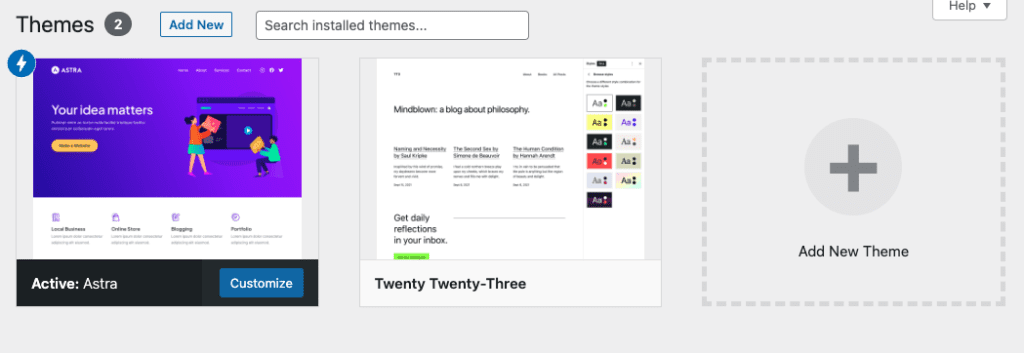
Don’t forget to activate the theme after installing it, or else it will not reflect on your website.
How to Customize your WordPress Theme
Using a theme is a good start, but you need to customize it to the feel and look you want. WordPress make it easy for even beginners to start customizing the theme. Users of all experience levels can easily customize features such as changing the header, fonts, and page layout.
To help you craft a stunning site, here are some design tips to consider when starting a blog:
Increase White Space:
Avoid clutter by incorporating white space around your copy and images. This enhances the cleanliness, simplicity, and effectiveness of your website design, keeping visitors focused on your content.
Avoid Stock Photos:
Opt to use unique images rather than stock photos to make your blog stand out. While professionally-taken images are ideal, you can leverage the power of your phone to capture complementary images for your blog posts. This will offer a more personalized touch for your audience.
Consistency with Icons:
Pay attention to details, ensuring consistency in the design and font of your social icons. This not only adds a professional touch but also contributes to the overall perception of your blog’s professionalism. You should maintain uniformity in font choices throughout the website, with minimal exceptions.
Use Strong Colors:
When incorporating colours, aim for high-contrast combinations. While white space is crucial, contrasting colours enhance readability and content retention. Striking a balance between white space and bold colours contributes to an aesthetically pleasing design.
Moderation in Design:
While creativity is encouraged, avoid going overboard with eccentric and quirky design elements. Adhere to basic design conventions to meet user expectations in terms of functionality. Embrace creativity within the established parameters of web design, especially when starting out.
By following these design tips, you can enhance the visual appeal and professionalism of your blog, creating an engaging and user-friendly experience for your audience.
Add features with plugins
WordPress plugins are essential for enhancing the functionality and features of your website. It allows you to tailor it to your specific needs and requirements. While WordPress comes with a robust set of built-in features, plugins extend its capabilities by providing additional tools and functionalities. Whether you want to improve your site’s search engine optimization (SEO), enhance security measures, optimize performance, or add interactive elements like forms and social media integration, plugins offer a convenient way to implement these features without extensive coding knowledge. The modular nature of plugins allows users to pick and choose the functionalities they need, transforming a basic WordPress site into a dynamic and feature-rich platform that caters to the unique goals and preferences of the website owner.
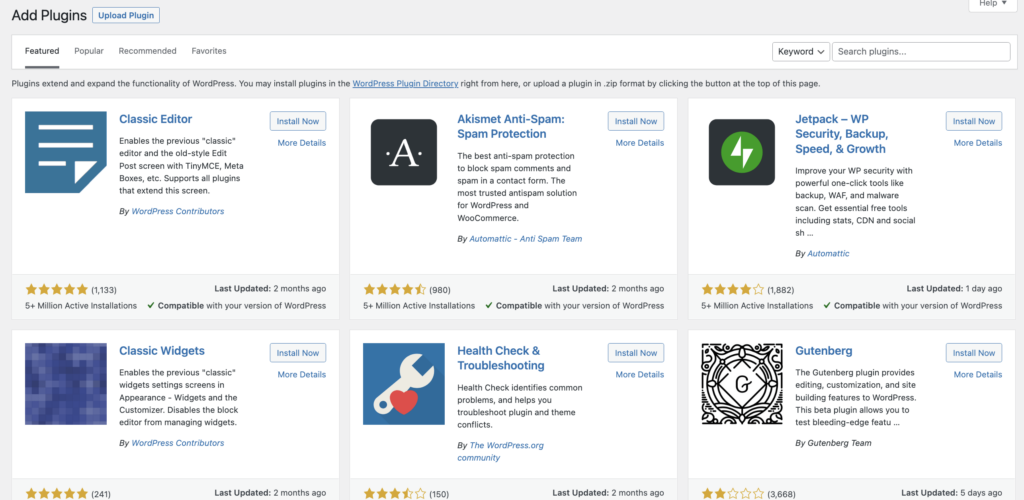
Furthermore, plugins contribute to the versatility and scalability of a WordPress website. As your site evolves and your needs change, you can easily adapt by installing or removing plugins. This flexibility is crucial for keeping your site up-to-date with the latest industry trends, technological advancements, and security measures. By harnessing the power of plugins, WordPress remains a highly adaptable and customizable content management system, catering to a wide range of users from bloggers and small businesses to large enterprises, each with its own distinct requirements for website functionality and user experience.
To install a new plugin, you can look for the Plugins option from the left navigation bar. From there, choose Add New. Then, you will be directed to the plugin store. Here you can explore different plugins for your WordPress website.
Useful Plugins for WordPress
Here’s a list of useful WordPress plugins, along with explanations of why they can be beneficial:
Yoast SEO: Helps optimize your blog for search engines.
It provides tools for improving on-page SEO, generating XML sitemaps, and optimizing content for better search engine visibility.
Akismet Anti-Spam: Protects your blog from spam comments.
Akismet automatically filters out spam comments, saving you time and maintaining the quality of your blog’s comment section.
W3 Total Cache: Improves website performance by caching.
W3 Total Cache helps reduce server load and speeds up page load times, enhancing the user experience and improving SEO.
UpdraftPlus: Provides backup and restoration functionalities.
UpdraftPlus allows you to schedule backups and easily restore your site in case of emergencies. Regular backups are essential for avoiding data loss.
MonsterInsights: Google Analytics integration for WordPress.
MonsterInsights helps you to track user engagement, understand your audience, and make data-driven decisions to improve your blog’s performance.
Wordfence Security: A comprehensive security plugin.
Wordfence Security protects your blog from security threats, including malware, and provides firewall protection to enhance the overall security of your site.
Jetpack by WordPress.com: Offers a suite of features including site stats, social sharing, and related posts.
Jetpack simplifies managing and enhancing your blog by consolidating various features in one plugin, reducing the need for multiple plugins.
Elementor: A powerful drag-and-drop page builder.
Why: Allows you to create visually appealing and customized pages without any coding knowledge, making it easier to design and structure your blog.
WPForms: A user-friendly form builder plugin.
WPForms enables you to create contact forms, surveys, and other interactive elements, enhancing user engagement and communication on your blog.
If you want to install a plugin, simply click on Install Now. When it’s installed, the button will change to Activate. Simply click on Activate, and your new plugin is ready to go! Always use only the plugins you need to avoid unnecessary load on your site.
Step 5: Create and publish posts
Get ready for an exciting milestone. The creation and publication of your inaugural blog post. It’s time to transform your thoughts into words and let your ideas take centre stage.
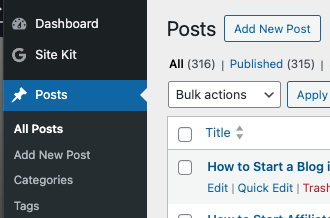
Writing that first blog post may feel like a daunting task with the blinking cursor on the blank page, but here’s a reassuring thought – every writer, even the most famous ones, began with that same blank page. This is your first step on the path to influencing, inspiring, and engaging with your audience, marking the beginning of an exhilarating journey.
Navigate back to your WordPress admin. In the left menu, locate the “Posts” tab. Hovering over it reveals another menu with four options. Opt for “Add New.”
This action will lead you to a blank post, providing you with the canvas to commence your first blog post! Pour your thoughts onto the page and, when satisfied, click “Publish” to make your post live on the site. Alternatively, you can save it as a draft for future editing.
Create content your audience wants to read
Now, it’s time to create your content! Regardless of your blog’s nature, you’re likely to find similar blogs online. Just look at the number of healthy living blogs available on the internet!
While these blogs may cover similar topics, what sets yours apart is your unique voice and insights. However, it’s essential to focus on creating content that captivates readers’ attention and encourages them to return. Here are a few strategies to make your blog stand out:
Create compelling headlines
The effectiveness of your blog post hinges on compelling headlines. If your headlines fail to captivate, readers may not venture far enough to discover the excellence of your blog content. Your headline stands as the primary opportunity to entice a reader into clicking on the post and delving into your thoughts on a particular topic.
The best headlines make a promise to your readers, offering answers to the precise problems they’re seeking to solve at that moment. This is why “How to” articles are often incredibly effective—they indicate a solution. It’s also beneficial to tease your readers without fully satisfying their curiosity in the headline. You leave that anticipation for the body of the post. Unfortunately, some headlines are crafted in a way that even a casual reader doesn’t need to delve into the lead sentence to satisfy their curiosity. However, it’s crucial not to deceive your readers; maintain transparency and deliver on the promises made in your headlines. By doing so, you build trust and ensure that your audience finds real value in your blog content.
How to write a good headline
If you’re uncertain about the subject for your next headline and, consequently, your blog post title, there are several effective ways to determine what will resonate most with your target market:
- Check Comment Sections:
- Explore the comment sections on your own blog posts and those of similar blogs within your niche. You need to pay attention to what people are discussing and the questions they’re asking. This can provide valuable insights into the topics that engage your audience and spark their interest.
- Use Content Insight Tools like BuzzSumo:
- Leverage content insight tools such as BuzzSumo to gain valuable data on the most popular posts within your market. These tools analyze trending content, helping you identify topics that are currently resonating with your target audience. This can inform your decision on what to focus on in your next blog post.
- Engage with Your Subscribers:
Reach out to your subscribers and tap into the insights of those who are most loyal to your blog and brand. Subscribers often appreciate being involved in the content creation process and are willing to share their preferences and desires. You may conduct surveys or simply ask for feedback to understand what topics your audience is most interested in.
By actively engaging with your audience through comments, utilizing content insight tools, and seeking input from your subscribers, you can gather valuable information to guide your content strategy. This ensures that your headlines and blog post topics align with the interests and preferences of your target market, increasing the likelihood of resonating with your audience.
Write attention-grabbing intros
Once your headline has successfully captured a viewer’s attention, it’s crucial not to lose momentum. The fact that you’ve enticed them past the headline is a significant achievement. And now, your focus should be on keeping them engaged.
This task, however, is no easy feat.
The key lies in explaining to your readers why the topic you’re addressing is important, not in a broad and abstract sense, but in a way that is specifically relevant to them at the present moment. The emphasis should be on making the content personally significant to your audience.
One common mistake many people make, particularly when writing their initial blog posts, is veering towards being overly academic or excessively casual. While it’s essential to present real facts in your introduction to establish credibility, it’s equally important to strike a balance.
Readers generally do not want to delve into an academic lecture, yet they seek content that is informative and engaging.
Therefore, your introduction should offer valuable information in a way that resonates with your audience’s immediate concerns, combining substance with accessibility. By striking this balance, you can maintain reader engagement and ensure that your blog remains both informative and enjoyable.
Make your content meaningful
In contrast to YouTube content, which can be a time-consuming vortex for users, engaging with a blog requires a more deliberate effort from the audience. Consequently, it becomes crucial to ensure that your blog offers substantial value to justify your readers’ investment of time and attention.
The most effective approach is to fulfil the promise your headline made — deliver the solutions and advice you committed to providing. The objective is to make your solution or advice, addressing the specific problems your readers are encountering, both straightforward and irresistibly compelling.
By delivering on your promises and offering practical insights, you make your blog a valuable resource for your audience. This not only enhances their overall experience but also establishes trust and encourages them to return for more content in the future.
Make your posts easy to scan
Making your posts easy to scan is crucial for capturing and retaining the attention of online readers who often engage in quick browsing. One effective strategy is to employ clear and concise headings and subheadings.
Break down your content into digestible sections, each with a descriptive header that summarizes the main point. This not only helps readers quickly identify the topics they are interested in but also provides a roadmap for those who prefer to skim the content before delving into details.
Additionally, use bullet points or numbered lists to present information in a structured and organized manner. Lists are visually appealing and make it easy for readers to grasp key points without having to read through dense paragraphs.
Optimize Your Blog For Search Engines
Having a visually appealing blog with high-quality content is only part of the equation. Instead, the next step is ensuring that people discover it. While sharing snippets on social media and distributing business cards can be helpful, organic searches are often the primary source of traffic. This is especially true if you don’t plan on investing in paid advertising.
To maximize your visibility and attract more visitors, it’s crucial to implement a robust SEO (search engine optimization) strategy for your blog. SEO is the practice of optimizing your content and website to rank higher in search engine results when your target audience searches for relevant topics online.
A valuable tool to assist you in this is the Yoast SEO plugin. Known for its user-friendly interface and effectiveness, this plugin simplifies the optimization process, helping you enhance your blog’s visibility in search engines. By strategically incorporating relevant keywords, improving meta tags, and ensuring your content aligns with SEO best practices, you can boost your blog’s traffic and increase its chances of being discovered by your target audience.
Final thoughts on creating a blog on WordPress
Embarking on the journey of creating a blog on WordPress can be an exciting and rewarding experience. WordPress offers a user-friendly platform that caters to both beginners and experienced bloggers. It provides a range of customizable themes and plugins to enhance the overall look and functionality of your site.
As you dive into the world of blogging, it’s crucial to focus on creating valuable, well-crafted content that resonates with your target audience. Consider your niche, define your unique voice, and maintain consistency in posting to keep your readers engaged.
You can leverage the various features of WordPress, such as categories and tags, to organize your content effectively, making it easy for visitors to navigate your blog and discover relevant topics.




